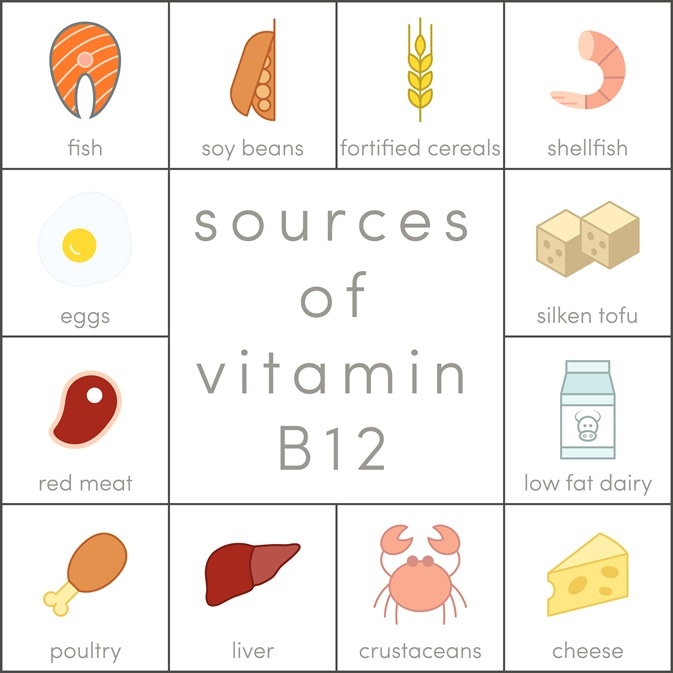Vitamin B12, also known as cobalamin, has many diverse functions in the human body. For this reason, its deficiency produces a spectrum of clinical manifestations.
About 15 percent of adults above 65 years have subclinical deficiency, probably contributed to by the use of H2-receptor blockers for hyperacidity treatment, since these also reduce cobalamine levels.

Causes
Vitamin B12 deficiency may arise due to:
- Nutritional deficiency especially in elderly individuals on restricted diets, and alcoholics
- Malabsorption syndromes such as pernicious anemia
- Gastrointestinal disorders leading to malabsorption such as atrophic gastritis or H2-receptor blocker use for prolonged periods
- Others such as Whipple’s disease or Crohn’s disease, intestinal surgery or strictures with resulting bacterial overgrowth that competitively take up vitamin B12 in the ileum
Clinical features
Hematologic
Classically, vitamin B12 deficiency has been associated with megaloblastic macrocytic anemia. The blood counts show a high mean corpuscular volume, and elevated mean corpuscular hemoglobin.
Peripheral smear examination shows the presence of macroovalocytes, with neutrophil hypersegmentation. However, almost a third of patients have normal hemoglobin.
Neurologic
Cobalamin deficiency is associated with:
- Paresthesias
- peripheral neuropathy
- demyelination of the corticospinal tract and dorsal columns (subacute combined systems disease)
Psychiatric
Vitamin B12 deficiency has also been associated with:
- Memory loss
- Irritability and depression
- Dementia
- Psychosis, though rare
Cardiovascular
It may increase the risk of myocardial infarction and stroke.
Diagnosis and Management
Diagnosis is based on serum cobalamin assays (less than 200 pg/mL/ or 150pmol/L). However, the assays fail to detect deficiency in older patients, even when it is severe enough to precipitate neuropsychiatric disease.
Other more sensitive tests are now available, which test for serum methylmalonic acid and serum homocysteine levels. These show increases earlier in the course of deficiency, before hematologic manifestations set in. However, methylmalonic acid levels rise in renal disease. Again, folic acid deficiency may lower the assayable levels of B12 while increasing homocysteine levels.
Oral cobalamin is a safe and effective way of supplementing the vitamin even in deficiency states, including pernicious anemia. 1,000 to 2,000 mcg should be administered daily for one to two weeks, followed by a maintenance dose of 1,000 mcg per day lifelong.
Injections may also be given following the traditional course of treatment, but these are more labor-intensive and painful. In this case the dose for intramuscular injection is typically 100 to 1,000 mcg every day or alternate day, for one to two weeks. This would need to be followed by 100 to 1,000 mcg administered by injection every one to three months.
References
- http://www.aafp.org/afp/2003/0301/p979.html
- http://www.aafp.org/afp/2011/0615/p1425.html
- https://www.ncbi.nlm.nih.gov/pubmedhealth/PMHT0022013/
- https://www.ncbi.nlm.nih.gov/pmc/articles/PMC3257642/
Further Reading
- All Vitamin B12 Content
- Symptoms of Vitamin B12 Deficiency
- Causes of Vitamin B12 Deficiency
- Managing Vitamin B12 Deficiency
- How is Vitamin-B12 Related to Anemia?
Last Updated: Feb 27, 2019

Written by
Dr. Liji Thomas
Dr. Liji Thomas is an OB-GYN, who graduated from the Government Medical College, University of Calicut, Kerala, in 2001. Liji practiced as a full-time consultant in obstetrics/gynecology in a private hospital for a few years following her graduation. She has counseled hundreds of patients facing issues from pregnancy-related problems and infertility, and has been in charge of over 2,000 deliveries, striving always to achieve a normal delivery rather than operative.
Source: Read Full Article